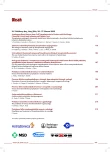The Salvage of Ischaemic Limb by Therapeutical Angiogenesis
Authors:
R. Talapková 1; J. Hudeček 2; I. Šinák 1; P. Kubisz 2; Ľ. Laca 1; Ľ. Hlinka 1; K. Zeleňák 3
Authors‘ workplace:
Klinika transplantačnej a cievnej chirurgie Jesseniovej lekárskej fakulty UK a MFN Martin, Slovenská republika, prednosta doc. MUDr. Ľudovít Laca, Ph. D., mim. prof.
1; Klinika hematológie a transfuziológie Jesseniovej lekárskej fakulty UK a MFN Martin, Slovenská republika, prednosta prof. MUDr. Peter Kubisz, DrSc.
2; Klinika rádiologie Jesseniovej lekárskej fakulty UK a MFN Martin, Slovenská republika, prednosta MUDr. Hubert Poláček, Ph. D.
3
Published in:
Vnitř Lék 2009; 55(3): 179-183
Category:
15th Parizek's Days
Overview
Background:
Critical limb ischaemia (CLI) is defined as a chronic rest pain, lasting more than 2 weeks, requiring analgesics and/or with present skin defects. Autologous transplantation of bone marrow mononuclear cells has been used successfully in CLI.
Aim:
The salvage of critically ischaemic limb by endotel progenitory cells (EPCs) from patient’s bone marrow. To assess efficacy and safety of critical lower limb ischaemia treatment with marrow stem cell autotransplantation.
Methods:
9 patients suffering from CLI have been enrolled. They did not require emergency amputation and had previously been unsuccessfully treated with conventional therapy. Mononuclear cells were isolated from the bone marrow taken from illiac crest and injected in the gastrocnemius muscle and pedal region of the affected limb. Patients have had evaluated: local finding, pain index, quality of life index, ABI, fotopletysmography, markers of endothelium and trombocytes’ activation and digital subtractive angiography.
Results:
Pain severity decreased in all of patients. Three of them are with no pain and no claudication. Lesions resolved in two patients, partially in three patients. Crural amputation was required in two patients, amputation of leg in 1 patient. No side effects of the therapy were observed. One patient died without connection with procedure.
Conclusions:
Marrow stem cell autotransplantation into the ischaemic lower limb seems to be a potentially effective method of peripheral perfusion enhancement. Further studies are needed to clarify the underlying mechanisms of such improvement.
Key words:
critical limb ischemia – bone marrow stem cells – therapeutical angiogenesis
Sources
1. Norgren L, Hiatt WR, Dormandy JA et al. TASC II Working Group (2007). Inter-Society Consensus for the Management of Peripheral Arterial Disease (TASC II). Eur J Vasc Endovasc Surg 2007; 33 (Suppl 1): S1–S75.
2. Li WW, Li VW, Tsakayannis D. Angiogenesis in Wound Healing. Cont Surg 2003; (Suppl): 36.
3. Madeddu P. Therapeutic angiogenesis and vasculogenesis for tissue regeneration. Exp Physiol 2005; 90: 315–326.
4. Rissanen TT, Vajanto I, Yia-Hertuula S. Gene therapy for therapeutic angiogenesis in critically ischaemic lover limb – on way to the clinic. Eur J Clin Invest 2001; 31: 651–666.
5. Tateishi-Yuyama E, Matsubara H, Murohara T et al. Therapeutic angiogenesis for patients with limb ischaemia by autologous transplantation of bone-marrow cells: a pilot study and a randomised controlled trial. Lancet 2002; 360: 427–435.
6. De Vriese AS, Billiet J, Van Droogenbroeck J et al. Autologous transplantation of bone marrow mononuclear cells for limb ischemia in a caucasian population with atherosclerosis obliterans. J Int Med 2008; 263: 395–403.
7. Nizankowski R, Petriczek T, Skotnicki Aet al. The treatment of advanced chronic lower limb ischaemia with marrow stem cell autotransplantation. Kardiol Pol 2005; 63: 351–360; discussion 361.
8. Semenza GL. Therapeutic angiogenesis. Another Passing Phase? Circ Res 2006; 98: 1115–1116.
9. Matsuda H. The Current Trends and Future Prospects of Regenerative Medicine in Cardiovascular Diseases. Asian Cardiovasc Thorac Ann 2005; 13: 101–102.
10. Soda T, Suzuki H, Kusuama T et al. Improvement of severe ulcer of buerger’s disease by bone-marrow mononuclear cell transplantation: a case report. In: New Frontiers in Regenerative Medicine. Springer Japan 2007: 95–100.
11. Wester T, Jørgensen TT, Stranden E et al. Treatment with autologous bone marrow mononuclear cells in patients with critical lower limb ischaemia. A pilot study. Scand J Surg 2008; 97: 56–62.
12. Dimmeler S. Platelet-Derived Growth Factor CC – A Clinically Useful Angiogenic Factor at Last? N Engl J Med 2005; 352: 1815–1816.
13. Lenk K, Adams V, Lurz P et al. Therapeutical potential of blood-derived progenitor cells in patients with peripheral arterial occlusive disease and critical limb ischaemia. Eur Heart J 2005; 26: 1903–1909.
Labels
Diabetology Endocrinology Internal medicineArticle was published in
Internal Medicine

2009 Issue 3
Most read in this issue
- Laboratory procedures following thrombocytopenia diagnosis
- Pre‑operative care for cardiac surgery patients with cold antibody disorder, cryoglobulinaemia and cryofibrinogenemia
- Venous thromboembolism prophylaxis in orthopaedics and traumatology
- Antithrombotic prophylaxis during pregnancy
